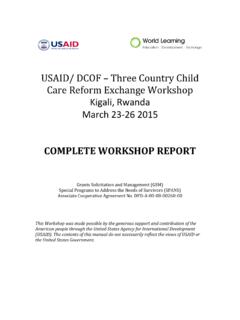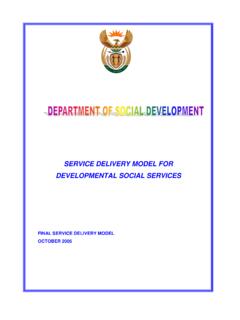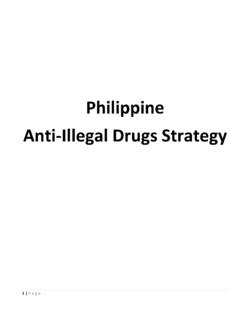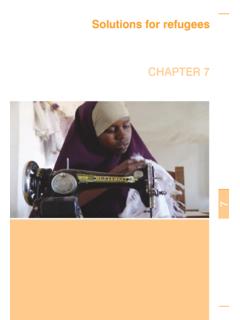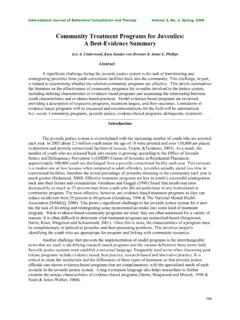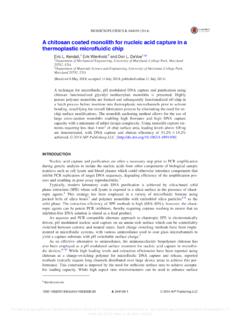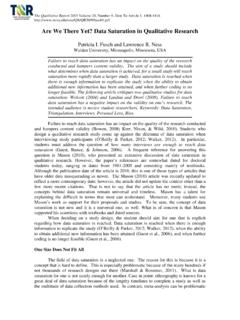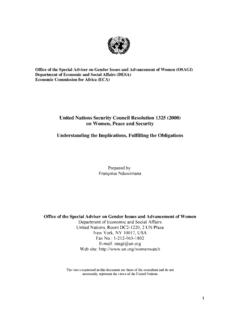Transcription of Peacebuilding 1 Sustaining Peace What does “sustaining ...
1 On 27 April 2016, the General Assembly and the Security Council adopted substantively identical resolutions on Peacebuilding (A/RES/70/262 and S/RES/2282 (2016), respectively), concluding the 2015 review of the UN Peacebuilding Architecture. These resolutions are the most comprehensive and far-reaching resolutions on this issue. This ground breaking achievement outlines a new ambitious agenda and approach for Peacebuilding . Member States demonstrated their commitment to strengthening the United Nations ability to prevent the outbreak, escalation, continuation and recurrence of [violent] conflict, address the root causes and assist parties to conflict to end hostilities in order to save succeeding generations from the scourge of war as stated in the opening sentence of the UN Charter.
2 What does Sustaining Peace mean? 1 The resolu*ons introduce the term Sustaining Peace , which, rather than redefining Peacebuilding , provides for more clarity and an expanded scope. During the 1990s, Peacebuilding was mostly understood in the UN as post-conflict Peacebuilding . However, that posi*on changed in the 2000s with the adop*on of Security Council Presiden*al Statement S/PRST/2001/15 and the following 2007 Policy CommiPee decision that defined Peacebuilding as aiming to prevent the outbreak, the recurrence or the con*nua*on of armed conflict.
3 This posi*on was reaffirmed in the new resolu*ons A/RES/70/262 and S/RES/2282 in the preamble, when it states that Sustaining Peace encompasses ac*vi*es aimed at preven*ng the outbreak, escala*on, con*nua*on and recurrence of conflict. Sustaining Peace should in prac*cal terms not be dis*nguished from Peacebuilding . It does not imply any redefini*on of respec*ve roles, responsibili*es or mandates of UN en**es. Both Sustaining Peace and Peacebuilding are ul*mately intended to reduce the risk of lapse or relapse into violent conflict.
4 It can be seen as an aspira*onal goal, aiming at fostering the ability and capacity to look beyond crisis management and the immediate resolu*on of conflicts. The resolu*ons offer an opportunity to increase the focus of the UN system to preven*ng conflicts, so that not only the symptoms, but also the root causes of conflicts are addressed. Hence, the concept aims at tackling issues that may otherwise fuel new cycles of new resolu*ons stress that Sustaining Peace is a shared task that should flow through all three pillars of the UN system s engagements at all stages of the conflict, and in all its dimensions.
5 The resolu*ons offer an opportunity to increase the focus and capacity of the UN system to prevent violent conflicts, and Member States, civil society organiza*ons and the UN system need to seize the opportunity presented by the resolu*ons. Sustaining Peace should not be viewed as rebranding exis*ng work but rather as a more prac*ce-oriented comprehensive concept to prevent violent conflict, by addressing drivers of conflict, paPerns of viola*ons of human rights and interna*onal humanitarian law and underlying root causes of conflict, including different kinds of exclusion, systemic discrimina*on and marginaliza*on with renewed vigour, based on joint analysis of conflict dynamics and joined-up strategic planning.
6 The resolu*ons are reinforced by other agreements and reports, including the report of the High-Level Independent Panel on Peace Opera*ons (HIPPO) and the Secretary-General s follow up to the report, the 2030 Agenda for Sustainable Development and the World Humanitarian Summit, which all emphasize the importance of preven*ng violent conflicts. PeacebuildingSustaining PeacePeacebuildingSustaining PeaceSustaining Peace : the what PeacebuildingSustaining Peace2a goal and a process; [PP 8] Ac*vi*es aimed at preventing the outbreak, continuation, escalation and recurrence of violent conflict; addressing root causes; assis*ng par*es to conflict to end hos*li*es; ensuring na*onal reconcilia*on; and moving towards recovery, reconstruc*on and development.
7 [PP 8] Inherently a poli*cal process as addressing root causes and ending hos*li*es requires finding poli*cal solu*ons; [PP 13] and requires a comprehensive, coordinated and coherent approach, which could include: All programmes and ac*vi*es should be conflict sensi*ve and do no harm guided by a conflict analysis. Broadly, depending on the theory of change based on an analysis of the causes and drivers of conflict, they could be clustered in two groups: a)Ac*vi*es that are designed and directly aimed at Sustaining Peace ; and b)Ac*vi*es that, while not explicitly designed to sustain Peace , can contribute to Sustaining Peace .
8 The concept of Sustaining Peace should, according to the resolu*ons, be broadly understood as: processes, including elections; inclusive dialogue; reconciliation; and conflict-management capacity at national and subnational levels; and security, including mine action; disarmament, demobilization and reintegration; and security sector reform; of law and human rights, including access to justice; transitional justice (including mechanisms for truth-seeking, accountability, reparation and guarantees of non-recurrence); promotion and protection of human rights; gender equality; protection of civilians, including compliance with and accountability for applicable international humanitarian, human rights and refugee law; and voluntary, safe and durable solutions for internally displaced persons and refugees.
9 Services, such as water and sanitation, health and education, including to the most vulnerable, such as victims of violence, internally displaced persons and refugees; government functions, in particular basic public administration and public financial management, at the national, subnational and local levels, including transparency, accountability and anti-corruption; and revitalization and livelihoods, including employment, livelihoods and Peace : The when Peacebuilding is no longer treated only as a post-conflict ac*vity, but should be a priority during all stages of the conflict cycle before, during and after, implying that Sustaining Peace should take place simultaneously with peacekeeping, development and humanitarian ac*vi*es.
10 [PP 8] Sustaining Peace requires a long-term perspec*ve by na*onal (state and non-state) counterparts and a long-term engagement by the UN system and interna*onal community in terms of political, technical and financial support. [OP 4, 8, 13] Violent conflicts are r a r e ly l i n e a r , s e q u e n t i a l p r o c e s s e s (moving from development to violence to humanitarian assistance and from peacemaking to peacekeeping and Peacebuilding , followed by sustainable Peace and development).










